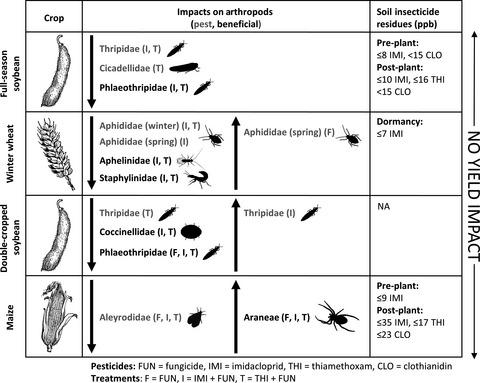当前位置:
X-MOL 学术
›
J. Appl. Ecol.
›
论文详情
Our official English website, www.x-mol.net, welcomes your feedback! (Note: you will need to create a separate account there.)
Ecological impacts of pesticide seed treatments on arthropod communities in a grain crop rotation
Journal of Applied Ecology ( IF 5.7 ) Pub Date : 2020-03-22 , DOI: 10.1111/1365-2664.13595 Aditi Dubey 1 , Margaret T. Lewis 1 , Galen P. Dively 1 , Kelly A. Hamby 1
中文翻译:

谷物轮作中农药种子处理对节肢动物群落的生态影响
更新日期:2020-03-22
Journal of Applied Ecology ( IF 5.7 ) Pub Date : 2020-03-22 , DOI: 10.1111/1365-2664.13595 Aditi Dubey 1 , Margaret T. Lewis 1 , Galen P. Dively 1 , Kelly A. Hamby 1
Affiliation

|
- While many studies have investigated non‐target impacts of neonicotinoid seed treatments (NSTs), they usually take place within a single crop and focus on specific pest or beneficial arthropod taxa.
- We compared the impacts of three seed treatments to an untreated control: imidacloprid + fungicide products, thiamethoxam + fungicide products and fungicide products alone in a 3‐year crop rotation of full‐season soybean, winter wheat, double‐cropped soybean and maize. Specifically, we quantified neonicotinoid residues in the soil and in weedy winter annual flower buds and examined treatment impacts on soil and foliar arthropod communities as well as on plant growth and yield.
- Unquantifiably low amounts of insecticide were found in winter annual flowers of one species in one site year, which did not correspond with our treatments. Although low levels of insecticide residues were present in the soil, residues were not persistent. Residues were highest in the final year of the study, suggesting some accumulation.
- We observed variable impacts of NSTs on the arthropod community; principle response curve and redundancy analyses exhibited occasional treatment effects, with treatments impacting the abundance of various taxa, including predators and parasitoids. Overall, foliar taxa were more impacted than soil taxa, and the fungicides occasionally affected communities and individual taxa.
- Pest pressure was low throughout the study, and although pest numbers were reduced by the insecticides, corresponding increases in yield were not observed.
- Synthesis and applications. Pesticide seed treatments can impact arthropod taxa, including important natural enemies even when environmental persistence and active ingredient concentrations are low. The foliar community in winter wheat showed that in some cases, these impacts can last for several months after planting. Given the low pest pressure and lack of yield improvement in full‐season soybean, double‐cropped soybean, winter wheat and maize, we did not observe benefits that could justify the risks associated with neonicotinoid seed treatment (NST) use. Our results suggest that NSTs are not warranted in Maryland grain production, outside of specific instances of high pest pressure.
中文翻译:

谷物轮作中农药种子处理对节肢动物群落的生态影响
- 尽管许多研究已经调查了新烟碱种子处理(NST)的非目标影响,但它们通常发生在单一作物中,并且侧重于特定的害虫或有益的节肢动物类群。
- 我们将三种种子处理与未处理的对照的影响进行了比较:吡虫啉+杀菌剂产品,噻虫嗪+杀菌剂产品和单独使用杀菌剂的全季大豆,冬小麦,双季大豆和玉米的三年轮作。具体来说,我们量化了土壤和杂草冬季一年生花蕾中的新烟碱残留量,并研究了处理对土壤和叶节肢动物群落以及植物生长和产量的影响。
- 在一个地点一年中,一种物种的冬季一年生花中发现的杀虫剂数量极低,这与我们的处理方法不符。尽管土壤中存在少量杀虫剂残留物,但残留物并非持久存在。残留量在研究的最后一年最高,表明有些积累。
- 我们观察到NSTs对节肢动物群落的影响各不相同。原理响应曲线和冗余分析显示偶尔的处理效果,其中处理会影响各种类群的数量,包括捕食者和寄生类。总体而言,叶类群比土壤类群受到的影响更大,而杀菌剂有时会影响社区和个体类群。
- 在整个研究过程中,虫害压力均较低,尽管杀虫剂可减少虫害数量,但未观察到相应的产量增加。
- 综合与应用。农药种子处理即使在环境持久性和有效成分浓度较低的情况下,也可能影响节肢动物类群,包括重要的天敌。冬小麦的叶面群落表明,在某些情况下,这些影响可能在播种后持续数月。鉴于全季大豆,双季大豆,冬小麦和玉米的病虫害压力低且单产不足,我们没有观察到可以证明与使用新烟碱种子处理(NST)相关的风险的正当理由。我们的结果表明,除害虫压力高的特定情况外,马里兰州谷物生产中不需使用NST。



























 京公网安备 11010802027423号
京公网安备 11010802027423号